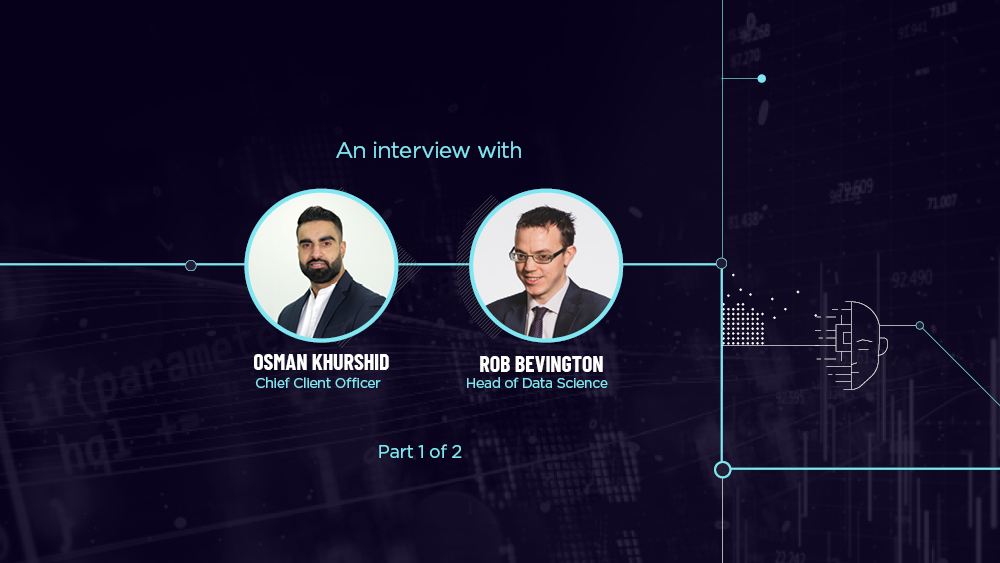We know. No crystal ball involved.
What’s driving AI innovation in fraud is demonstrable real-world value. Or rather, the process of getting proof that a particular suite of AI algorithms works to deliver against real world business objectives. Only by going through this process can you learn, improve and perfect. It’s how our own Precision software was born - as a proof of concept (PoC). It’s also the reason Precision is able to keep helping customers tackle emerging challenges.
In this blog, the first in a 2-part interview series, we caught up with our Chief Client Officer Osman Khurshid, and Head of Data Science Rob Bevington, to look at a brief history of AI PoCs at Synectics, and at how they have shaped some of the most powerful counter-fraud data tools in the industry.
Q - Welcome both. Perhaps you could start by telling us a about how Precision came to be?
A - Rob: Back in 2015 Synectics was already working with many of the UK’s largest financial services organisations, helping them to identify fraud through advanced data matching analytics. But fraud doesn’t stand still. So we don’t either. Some fellow data analysts and I had already begun working on turning decision trees into fully functioning predictive modelling algorithms, and we were getting some impressive results.
We saw that pairing National SIRA data with our modelling algorithms and customer information, was an invaluable combination. In fact, early PoCs showed us that adding in key trends from syndicated data increased the accuracy of the predictive models by over 30%. It was a compelling proposition. Exploring this concept further led to the birth of our Data Science team and eventually, Precision.
Q - How did you set about going from concept to product?
A - Osman: Through customer collaboration. In fact, it was an early adopter that came up with the name – contracting ‘Predictive Decision’ to ‘Precision’.
The PoC we set up with this motor insurance provider was initially focussed on showing how predictive analytics could be used to identify ‘Crash for Cash’ cases. It was extremely successful. In fact, an enriched optimised AI model is still being used by them today. It also showed us that the best results would be achieved by tailoring models to an organisation’s specific objectives, risk appetite and operational practices. Bearing this in mind we ensured that our approach moving forward was always business-led rather than technology-led.
We carried out our second PoC in the mortgage fraud space, where we were able to identify over 40% more fraud whilst reducing the investigated cases by 73%, saving our customer time and money in terms of streamlining their investigative resource.
Q - How did you build on these initial PoC projects to shape the Precision offering?
A - Osman: We looked at ways in which we could enrich the data utilised to further improve results, for example how incorporating unstructured data could help. Especially in Motor Insurance. For instance, using accident information recorded in the FNOL form really helped identify ‘Crash 4 Cash’, phantom and exaggerated claims. This process of reviewing and refining goes on still, with results continuing to demonstrate business value – for example reducing the cases required to work by 50% whilst finding 30% more fraud in the identification of false ID and 3rd party fraud, alongside identifying higher risk claims at FNOL.
A- Rob: As Oz says, we move forward by looking at ways we can integrate new data sources and evolving our feature engineering expertise to really maximise the power of our solutions. Working in this way we’ve developed a whole suite of AI options – and expanded access to more and more clients.
We started with Precision Enterprise models which were fully bespoke and tailored to the client’s exact pain points. We went on to expand this with Precision Standard which offers clients ‘day one’ fraud defences even without historic data – particularly useful for clients entering new markets. The next product we added was anomaly detection, which uses National SIRA, third party and customer data to detect activity as suspicious in context for that customer but not necessarily in terms of general fraud markers. It means customers find more fraud that is specific to them and often significant. These tools are gamechangers.
To learn more about integrating AI into your fraud prevention strategies, click here.
Related articles:
Insurance, Case studies and interviews, Ai and predictive analytics
AI PoCs for the counter-fraud hall of fame
Friday, November 3, 2023
Read moreSynectics, Company news
GDPR vs. The Data Protection Act - What does it mean for business?
Wednesday, February 15, 2017
Read moreInsurance, Ai and predictive analytics
Leveraging the Power of AI for Smarter Claims Processing
Tuesday, December 17, 2024
Read moreInterested?
Let us prove how we can help you. Click the button below for more details.
Find out more
